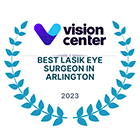Dry Eye Center of Excellence
Silk Vision & Surgical Center is pleased to announce we have started a Dry Center of Excellence. Dry eye disease affects close to 30 million Americans with symptoms such as eye redness, pain and decreased vision. Each year many Americans lose many hours of productivity because of this disease and left untreated it can lead to permanent decreased vision and ultimately loss of vision.
We realize that this is a chronic condition and has seriously affected the wellbeing of many people. There may not be a cure for dry eye disease but it can be managed and controlled with dry eye treatment. Our team is constantly searching for new treatment dry eye treatment options to add to our center. Our mission is to improve the lives of our patients, help restore their quality of life and preserve their vision.
During your exam we take time to discuss dry eye causes and customize a dry eye treatment plan for you based on the severity of your condition. Some the dry eye treatments include:
- Eye drops and gels that are preservative free
- Hot compresses and eyelid cleansers designed for dry eye patients
- Prescription eye drops such as cyclosporin and anti-inflammatory agents
- Using your own blood products to make autologous serum eye drops
- Micro exfoliation of the eyelids (Blephex) to deep clean the eyelids
- Thermal heat (Temspure Envy) to help dissolved the dried and clogged oil glands around the margin of the eyelids
Please contact us as we are here to help you!
Is virtual learning or computer vision hurting your eyes?
Today, more and more people (and especially students learning from home) are spending hours in front of computer and tablet screens. This can cause serious eye strain and dry eye symptoms. Let us help!
What Is Dry Eye?
Dry eye symptoms occur when the eye does not produce tears properly, or when the tears are not of the correct consistency and evaporate too quickly.
In addition, inflammation of the surface of the eye may occur along with dry eye symptoms. If left untreated, dry eye symptoms can lead to pain, ulcers, or scars on the cornea, and some loss of vision. However, permanent loss of vision from dry eye causes is uncommon.
Dry eye symptoms can make it more difficult to perform some activities, such as using a computer or reading for an extended period of time, and it can decrease tolerance for dry environments, such as the air inside an airplane.
What are tears, and how do they relate to dry eye?
Tears, made by the lacrimal gland, are necessary for overall eye health and clear vision. Tears bathe the surface of the eye, keeping it moist, and wash away dust and debris. They also help protect the eye from bacterial and other types of infections.
Tears are composed of three major components:
- outer, oily, lipid layer produced by the meibomian glands
- middle, watery, lacrimal layer produced by the lacrimal glands
- inner, mucous or mucin layer produced by goblet cells located within a thin transparent layer over the white part of the eye and covering the inner surface of the eyelids.
Tears are made of proteins (including growth factors), electrolytes, and vitamins that are critical to maintain the health of the eye surface and to prevent infection.
Tears are constantly produced to bathe, nourish, and protect the eye surface. They are also produced in response to emergencies, such as a particle of dust in the eye, an infection or irritation of the eye, or an onset of strong emotions. The lacrimal glands failing to produce sufficient tears could cause dry eye. Any disease process that alters the components of tears can make them unhealthy and cause dry eye.
What are the types of dry eye and what are the symptoms?
- An aqueous tear-deficient dry eye is a disorder in which the lacrimal glands fail to produce enough of the watery component of tears to maintain a healthy eye surface.
- Evaporative dry eye may result from inflammation of the meibomian glands, also located in the eyelids. These glands make the lipid or oily part of tears that slows evaporation and keeps the tears stable.
Dry eye symptoms can be associated with:
- inflammation of the surface of the eye, the lacrimal gland, or the conjunctiva
- any disease process that alters the components of the tears
- an increase in the surface of the eye, as in thyroid disease when the eye protrudes forward
- cosmetic surgery, if the eyelids are opened too widely.
What are dry eye symptoms?
Dry eye symptoms may include any of the following:
- stinging or burning of the eye
- a sandy or gritty feeling as if something is in the eye
- episodes of excess tears following very dry eye periods
- a stringy discharge from the eye
- pain and redness of the eye
- episodes of blurred vision
- heavy eyelids
- uncomfortable contact lenses
- decreased tolerance of reading, working on the computer, or any activity that requires sustained visual attention
- eye fatigue
Who is likely to develop dry eye?
Elderly people frequently experience dryness of the eyes, but dry eye can occur at any age. Nearly five million Americans 50 years of age and older are estimated to have dry eye. Of these, more than three million are women and more than one and a half million are men. Tens of millions more have less severe dry eye symptoms. Dry eye is more common after menopause. Women who experience menopause prematurely are more likely to have eye surface damage from dry eye.
What are the causes of dry eye?
Dry eye causes can be a temporary or chronic condition:
- Dry eye can be a side effect of some medications, including antihistamines, nasal decongestants, tranquilizers, certain blood pressure medicines, Parkinson’s medications, birth control pills and antidepressants.
- Skin disease on or around the eyelids can cause dry eye.
- Diseases of the glands in the eyelids, such as meibomian gland dysfunction, can cause dry eye.
- Dry eye can occur in women who are pregnant
- Women who are on hormone replacement therapy may experience dry eye symptoms. Women taking only estrogen are 70 percent more likely to experience dry eye symptoms, whereas those taking estrogen and progesterone have a 30 percent increased risk of developing dry eye.
- Dry eye can also develop after refractive surgery known as LASIK. These symptoms generally last three to six months but may last longer in some cases.
- Dry eye can result from chemical and thermal burns that scar the membrane lining the eyelids and covering the eye.
- Allergies can be associated with dry eye.
- Infrequent blinking, associated with staring at a computer or video screens, may also lead to dry eye symptoms.
- Both excessive and insufficient dosages of vitamins can contribute to dry eye. Homeopathic remedies may have an adverse impact on a dry eye condition. Loss of sensation in the cornea from long-term contact lens wear can lead to dry eye. Dry eye causes can be associated with immune system disorders such as Sjogren’s syndrome, lupus, and rheumatoid arthritis. Sjogren’s leads to inflammation and dryness of the mouth, eyes, and other mucous membranes. It can also affect other organs, including the kidneys, lungs and blood vessels.
- Homeopathic remedies may have an adverse impact on a dry eye condition.
- Loss of sensation in the cornea from long-term contact lens wear can lead to dry eye.
- Dry eye can be associated with immune system disorders such as Sjogren’s syndrome, lupus, and rheumatoid arthritis. Sjogren’s leads to inflammation and dryness of the mouth, eyes, and other mucous membranes. It can also affect other organs, including the kidneys, lungs and blood vessels.
- Dry eye can be a symptom of chronic inflammation of the conjunctiva, the membrane lining the eyelid and covering the front part of the eye, or the lacrimal gland. Chronic conjunctivitis can be caused by certain eye diseases, infection, exposure to irritants such as chemical fumes and tobacco smoke, or drafts from air conditioning or heating.
- If the surface area of the eye is increased, as in thyroid disease when the eye protrudes forward or after cosmetic surgery if the eyelids are opened too widely, dry eye can result.
- Dry eye may occur from exposure keratitis, in which the eyelids do not close completely during sleep.
Dry Eye Treatment
- Use artificial tears, gels, gel inserts, and ointments are available over the counter as the first line of therapy. They offer temporary relief and provide an important replacement of naturally produced tears in patients with aqueous tear deficiency. Avoid artificial tears with preservatives if you need to apply them more than four times a day or preparations with chemicals that cause blood vessels to constrict.
- Wearing glasses or sunglasses that fit close to the face (wraparound shades) or that have side shields can help slow tear evaporation from the eye surfaces. Indoors, an air cleaner to filter dust and other particles helps prevent dry eyes. A humidifier also may help by adding moisture to the air.
- Avoid dry conditions and allow your eyes to rest when performing activities that require you to use your eyes for long periods of time. Instill lubricating eye drops while performing these tasks.
- Be sure to drink enough water and avoid things that can cause dehydration such as large amounts of caffeine
What Is the iLUX System for Treating MGD and Dry Eyes?
The iLUX® Device is used to warm and compress glands in the eyelids of adult patients with a specific type of dry eye, called Meibomian Gland Dysfunction (MGD), also known as evaporative dry eye. Ask the team at Silk Vision about iLUX on your next visit.
Dry Eye Medication
Depending on the causes of dry eye, your doctor may use various approaches to relieve the dry eye symptoms.
Dry eye symptoms can be managed as an ongoing condition. The first priority is to determine if a disease is the underlying cause of the dry eye symptoms (such as Sjogren’s syndrome or lacrimal and meibomian gland dysfunction). If it is, then the underlying disease needs to be treated.
Cyclosporine, an anti-inflammatory medication, is the only prescription drug available as a dry eye treatment. It decreases corneal damage, increases basic tear production, and reduces dry eye symptoms. It may take three to six weeks to start to work and 3 months before receiving the months of twice-a-day dosages for the dry eye medication to work. In some cases of severe dry eye, short-term use of corticosteroid eye drops that decrease inflammation is required.
If dry eye results from taking a medication, your doctor may recommend switching to a medication that does not cause the dry eye side effect.
If contact lens wear is the problem, your eye care practitioner may recommend another type of lens or reducing the number of hours you wear your lenses. In the case of severe dry eye symptoms, your dry eye care professional may advise you not to wear contact lenses at all.
Another option is to plug the drainage holes, small circular openings at the inner corners of the eyelids where tears drain from the eye into the nose. Lacrimal plugs, also called punctal plugs, can be inserted painlessly by a dry eye care professional. The patient usually does not feel them. These plugs are made of silicone or collagen, are reversible, and are a temporary measure. In severe cases, permanent plugs may be considered.
In some cases, a simple surgery, called punctal cautery, is recommended to permanently close the drainage holes. The procedure helps keep the limited volume of tears on the eye for a longer period of time.
In some patients with dry eye symptoms, supplements or dietary sources (such as tuna fish) of omega-3 fatty acids (especially DHA and EPA) may decrease symptoms of irritation. The use and dosage of nutritional supplements and vitamins should be discussed with your primary medical doctor.
Contact Silk Vision at any of our convenient locations, including Annandale and Alexandria, to schedule your dry eye consultation and exam.










.png)
